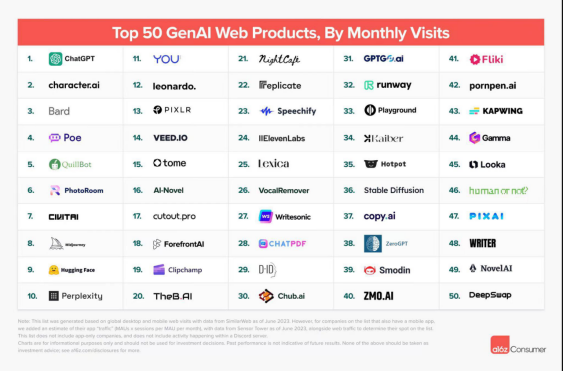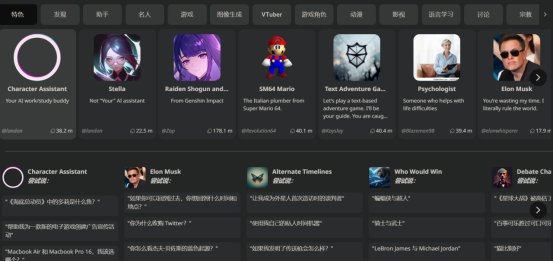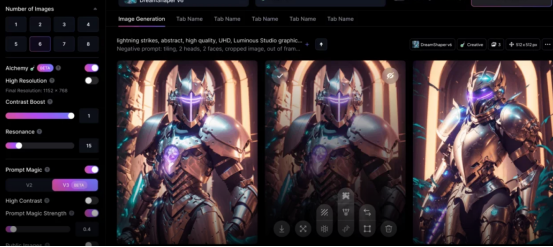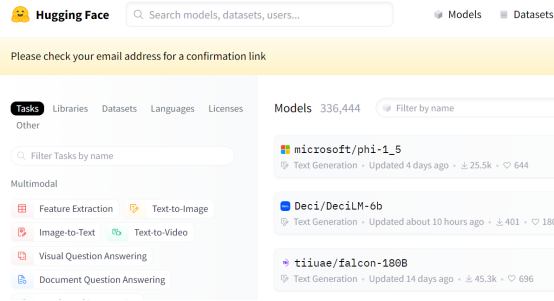Original: Mentioning the Big Names
Source: AI New Intelligence
Compared to domestic AI companies, most overseas peers have already achieved profitability in the application layer of AI, especially in consumer (C-end) applications. The vast majority of domestic applications, however, are still concentrated in the business (B-end) sector.
a16z is a venture capital company based in Silicon Valley, USA, established in 2009, with a deep background in the technology industry.
Due to its outstanding investment performance and industry influence, a16z has become one of the most prestigious venture capital companies globally.

Recently, a16z released a list of the top 50 AI products by monthly traffic. After analysis and comparison, an interesting phenomenon emerged.

Compared to domestic AI companies, most of these overseas peers have already achieved profitability in the application layer of AI, especially in consumer (C-end) applications. The vast majority of domestic applications, however, are still concentrated in the business (B-end) sector.
Divisions
From the list, the following characteristics can be observed in the current profitable overseas AI applications:
Most foreign AI applications are mainly focused on the consumer (C-end) market, with a subscription-based business model.
There are quite a few applications in the list that lean towards entertainment, such as emotional companionship and AI drawing.
Even in cases where these products lack core technological barriers, there are still a large number of users willing to pay.
For example, Character.Ai mentioned in the list is an emotional companionship AI for the consumer market. So far, users have created over 10 million custom AI characters. Users can chat with fictional characters or celebrities and create their own custom characters.

Another product mentioned in the list, Leonardo.ai, is also a subscription-based AI drawing application. Functionally, it is almost identical to the previously popular Midjourney.
However, even in the presence of many similar competitors and no core technological barriers, these consumer-focused drawing applications have still achieved profitability.
In contrast, the only prominent consumer AI application in the domestic market is the popular Meitu camera.

Apart from this, the main battlefield for domestic AI applications is still in the business (B-end) sector, whether it's intelligent customer service, office assistants, or text generation, most are services provided to enterprises.
For example, Baidu Intelligent Cloud launched "Comate" code assistant, which aims to help enterprises achieve fast code completion and automatic code error detection using the capabilities of Wenxin Yiyuan's large model.
Similarly, Kingsoft Office quickly launched the WPS AI intelligent office assistant by integrating Wenxin Yiyuan, which is also a B-end application based on the office field.
Similarly, DingTalk's "Slash" and 360's integration of its own suite of 360 Smart Brain have all focused on the B-end.
From an industrial perspective, this "specialization" in application direction may not necessarily be an optimistic situation.
Why, with such a huge user base and a broad market, is it still difficult for Chinese AI applications to flourish in the consumer market?
Three Major Constraints
Currently, the factors restricting the development of domestic AI companies in the consumer market mainly include "three major constraints."
- Lack of an active application ecosystem.
Compared to the domestic market, the AI application market in the United States, which has a first-mover advantage, is more mature and open, with more platforms and communities for AI application developers and users to interact and communicate.
For example, foreign AI application developers can use various online platforms and tools to quickly build and deploy AI applications.
Take Hugging Face as an example. The community has over 300,000 pre-trained models covering over 100 languages. Currently, there are over 500,000 organizations and individuals using Hugging Face, and they can share and evaluate models, datasets, and applications through various channels.

These platforms and tools can provide rich data resources, technical support, user feedback, community interaction, etc., for AI applications, reducing the development cost and difficulty, and allowing developers to directly understand the voice of users and what they want.
"Compliance" Constraint
This is another major constraint on current large-scale consumer applications in China.
In fact, during the competition for large-scale models in recent months, some lively consumer applications did emerge in China. However, in the overall environment, these communities or websites that were active for a short time were quickly taken down or closed due to legal or compliance reasons.
In early September, several small and medium-sized AI drawing websites built using AIGC technology in China, such as 4B3.com, xxx.com, and xxxart.com, were shut down without warning or moved to overseas domains, making them inaccessible in China.

The main reason for this phenomenon is "the use of overseas ChatGPT product interfaces without evaluation to provide intelligent dialogue and question-and-answer functions, which poses significant security risks."
Although some AI drawing community users and developers like to share their AI-generated works, such as using Stable Diffusion models or LoRA, due to the "compliance" constraint, if developers want to continue sharing their works, they may need to use some technical means to bypass regulation, which will undoubtedly increase their cost and difficulty, thereby reducing their willingness to share.
"Follow Strategy" Approach
As early as the rise of the Internet, major domestic enterprises in China adopted a "copycat" strategy, which is well known today. Various Internet products that people are familiar with today were originally "copied" from others.
For example, QQ imitated ICQ, Taobao imitated eBay, and Baidu imitated Google.
For countries and enterprises in a clearly disadvantaged position in the industry, this approach is understandable. After all, in an unknown new field, if a latecomer wants to create a completely new product without any cases in the market, the optimal solution to reduce risk and save costs is to follow.

Otherwise, if domestically produced AI applications with inferior computing power and data are required to take the lead and pave the way for the entire AI industry, this is obviously unreasonable and does not conform to business logic.
From this perspective, the "copycat" approach needs to involve micro-innovation, which essentially means low-risk innovation, maintaining the core of the original business model while adapting to domestic users.
免责声明:本文章仅代表作者个人观点,不代表本平台的立场和观点。本文章仅供信息分享,不构成对任何人的任何投资建议。用户与作者之间的任何争议,与本平台无关。如网页中刊载的文章或图片涉及侵权,请提供相关的权利证明和身份证明发送邮件到support@aicoin.com,本平台相关工作人员将会进行核查。




